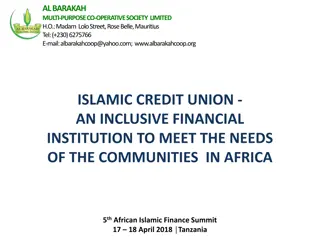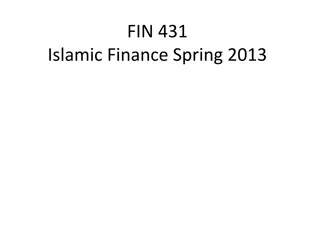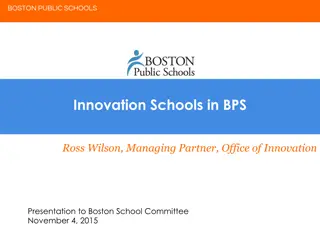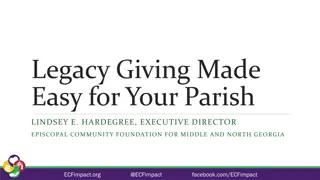History of Islamic Schools in the US: Lessons and Legacy
Explore the evolution of Islamic schools in the US, from community initiatives in the late 1960s to the establishment of the first schools in the late 70s and early 80s. Discover the continuous efforts to raise a generation of compassionate, faithful, and learned Muslims through institutions like the Bayaan Academy, aiming to prepare students to live Islam based on a clear understanding of the Quran and Sunnah. Uncover the stories behind the oldest Islamic school still in existence and the ongoing mission to nurture graduates who give back to their community.
Download Presentation

Please find below an Image/Link to download the presentation.
The content on the website is provided AS IS for your information and personal use only. It may not be sold, licensed, or shared on other websites without obtaining consent from the author.If you encounter any issues during the download, it is possible that the publisher has removed the file from their server.
You are allowed to download the files provided on this website for personal or commercial use, subject to the condition that they are used lawfully. All files are the property of their respective owners.
The content on the website is provided AS IS for your information and personal use only. It may not be sold, licensed, or shared on other websites without obtaining consent from the author.
E N D
Presentation Transcript
Raising a Generation of Compassionate, Faithful and Learned Muslims: Lessons from Bayaan Academy
Islamic Schools in the US Growing & Flourishing Aiming to raise a generation of Muslims ready to face the world Preparing our students to LIVE Islam through a clear understanding of the Qur an and Sunnah
History of Islamic Schools in the U.S.
In the late 1960s -1970s: A noted increase in the immigrant Muslim population. Community organizations were necessary to help the steadily increasing population of immigrant Muslims to hold on to their deen and provide alternative outlets for their American children. Masjid community organizations such as the MSA were established.
First established in the late 70s to early 80s. The University of Islam School established by Elijah Muhammad and his wife Clara in 1933 was actually the first school opened as an Islamic alternative to public schools or other parochial schools. The intent behind the University of Islam school was to provide an alternative for the Black Muslim children who were a part of the newly found Nation of Islam. NOI established separate schools out of necessity . Nadeem Ahmed Memon (2009)
Talk of starting full-time Islamic schools were being held, but commitment was lacking. Two pilot projects came out of an initiative started by an MSA education committee in mid- 1970 s Abdallah s Idris was the director of the pilot program in Mississauga, Ontario which is now the ISNA School. Dr. Seema Imam headed the Chicago pilot which is now the Universal School in Bridgeview, Illinois. These schools were started around 1983. (Chaudhry)
Oldest Islamic school still in existence is the Islamic Community School in Baltimore, MD that opened its doors in 1977. Zakia Amin, who has been the principal since 1980, stated that the school has maintained 40-50 students throughout its existence. The mission of the school is to continue on a small scale to produce graduates who will come back and contribute to the community . (Chaudhry 2014)
The first immigrant Islamic school was established in the mid 1970 s: Al Aqsa all girls high school in Bridgeview, IL Founded by early Palestinian immigrant community primarily to protect their girls from the evils of the American teenage scene of dating , wearing revealing clothing, and using bad language. This idea of protection from the ills of Western culture was the ideology that motivated the establishment of most immigrant schools. (Memon)
Most immigrant Muslims saw Islamic schools as a sort of reform school but not necessarily as a vehicle to bring them closer to the knowledge and worship of Allah. The three aims of Islamic schools were to: 1. Protect children from the ills of Western society; 2. Nurture Islamic thinking; 3. Match Academic standards of secular schools. (Memon)
Most of our current schools are going through or have gone through the following stages: The Challenge Stage The Stability Stage The Professional Stage (Dr. Hamid Ghazali)
I. The Challenge Stage Local community strives to open its Islamic school and to convince the community to enroll their children. Initial space is not designed as a school and lack of school environment has a negative effect on students. Certified teachers are hard to find and school has to depend on volunteers. Difficulties in paying bills and hiring enough auxiliary staff. The principal has to wear too many hats and her main responsibilities are left unfulfilled. Despite the difficulties, parents trust that their kids are in a safe place that is free of foul language, drugs, guns, sex, and other problems that public schools have.
II. The Stability Stage After the school passes the first two or three years safely things tend to stabilize. The number of students rises. Parents are impressed with how much their children have learned about Islam in a relatively short period. The personalities of many students tend to change and reshape, taking the Islamic model. Parents are becoming more involved in the school's daily affairs. Though the financial situation is still a major problem, the staff has confidence now that Allah is going to provide.
In fact, a feeling of competition among members of the community to support the Islamic school starts to appear. The curriculum has definitely improved. Additions are made one year after another. Physical education and art are integrated into the curriculum. Evaluation has become better and more accurate. The principal, the teachers, and the rest of the staff are looking at other schools to see how to improve theirs. Though the curriculum is not well defined for Islamic studies, Arabic and Qur'an, there are many improvements made in these subjects.
III. The Professional Stage At this stage, the school is accredited and more than eighty percent of the school's teachers are certified. When you walk into the school, you can feel that you are walking in a professional school. The office is well-maintained. Salaries in the school are competitive with other schools and firms. Teachers' and students' attendance is well maintained. The school has a nurse and a nursing room. Each department develops its curriculum and makes sure all of the textbooks are in stock. School policies are complete.
The elementary school is separated from the middle and high schools. The school has completed the construction of its science and computer lab, library and gym. Art is integrated into the curriculum for the elementary school and is offered as an elective for high school students. Parents make appointments before they can have a conference with a teacher or a staff member
In 2006, the New Horizon School in Pasadena is the first Islamic School to be awarded the much coveted prize issued by the U.S. Dept of Education The Blue Ribbon- for Excellence in Education. (Horizons) For the most part, during the last ten years, Islamic schools have focused more on strengthening the Academic and extracurricular programs. Still today in most Islamic schools the Qur aan, Arabic and Islamic Studies programs are lacking a standardized curriculum.
A number of entities have contributed towards providing vital resources for the establishment of Islamic Schools including: Islamic Education Communications Network (IECN), Islamic Schools League of America (ISLA) Council of Islamic Schools in North America (CISNA) Islamic Society of North America (ISNA) CISNA partnered with Advanced Ed to accredit Islamic schools. (Chaudhry 2014)
Pioneers in Islamic Education Bilal Ajieb and Dr. Zakiyyah Muhammad, African Americans instrumental in establishing and administering in Clara Muhammad schools and immigrant schools since the late 1970 s.. Abdullah Idris Ali who established the first Islamic School in Canada. There was also Dr. Seema Iman who served as principal for one of the earliest schools in the U.S. Dr. Tasmeena Ghazi who pioneered the effort for Islamic weekend schools and developed the first formal Islamic Studies curriculum . Salahuddin Abdul Kareem who played a major part in helping the establishment of Clara Muhammad schools. Dr. Maqbool Patel, one of the founders of the Al Rahmah school in Baltimore established in 1988 currently with nearly 400 students. Dauood Tauhidi founder of the Crescent Academy International School in Canton, Michigan now with over 400 students opened its doors in 1991. Ann El Moslimany; Freda Shamma; Susan Douglass; Ahmed Elkadi
History of Islamic Education in Tampa Muslim Community established in early 1970 s at Sligh Masjid (Mostly from Indian sub-continent) Weekend School developed & run by pioneers Second Masjid established with its weekend school in late 1980 s (Mostly Middle Eastern) 1991: Leaders from both communities came together to discuss establishment of Full-Time Islamic School
History of Islamic Education in Tampa 1991: Universal Academy of Florida registered with the state 1992: Board Members split Second School Registered with the state Islamic Academy of Florida August 28, 1992 Both Schools Opened K to Gr. 9 IAF 72 Students UAF 95 Students
Growth of the Schools through 2004 UAF Grew to 350 students; PreK to Gr. 12 Accredited by FCIS, FKC, & AdvancEd Strong Academics & AP Program IAF Had grown to 250 students, PreK Gr. 12, with emphasis on academics and community activism Suffered financial setbacks and went out of business; re-structured and re-opened as AYA in July 2004 with 215 Students, PreK Gr. 12
The Nurania Method Introduced into AYA in 2009 by Sr. Dalia El-deeb. Teachers from AYA, UAF, and Masjid Jamii weekend schools were trained and certified in the method. Improved the accuracy and fluency of students reading, especially in the lower grades.
Hifz Academy at Masjid Al-Jamii Hifz Academy was established at Masjid Al-Jamii for a handful of male students whose parents were interested in seeing their sons become hufathat-ul-Qur an. Over the past seven years, the school has grown to accept girls, as well as boys, and, this year (2017) added a full academic track for students in Kindergarten to Gr. 9. Current Enrollment is over 100 students, and the school continues to grow. A Daar-ul-Uloom program was added as an option for students in Middle and High School. Hifz Academy is looking towards accreditation in the near future.
UAF & AYA in 2015 Both schools continued to grow and flourish. UAF: 700+ students with strong AP Program; fully accreditation maintained. Began after-school Hifdh Program AYA: 500+ students with IB Program and full accreditation with FCIS, FKC & AdvancEd. Hifdh Program had been started for select students (after lunch to Dismissal) NEITHER school had achieved the level of Arabic & Qur an mastery it had hoped for: Diversity of student population as far as WHAT was important to their families Lack of the teachers faith in the abilities of the students Lack of support from all parents, teachers and administrators
Bayaan Academy: Developing Torchbearers for Future Generations Founded in August 2015 as a Homeschool Co-Op by Board Members and Administrators who had left AYA and were interested in having a school where Qur an, Arabic and Islamic Education were on equal footing with the core academic subjects, and where excellence was key. The mission was to have a school where character- building based on the foundation of Qur an and Sunnah were just as important as preparing the students for excellence in any educational and/or career field.
Bayaan Academy Stats August 2015: Opened as Home School Co-Op with 12 students in Gr. 3, 5 & 7 August 2016: Opened with 39 students (Max Capacity) in Gr. K to Gr. 4, 6 & 8 August 2017: Registered with the state as a Full-Time Private School January 2018: Secured 2nd Campus for 2018-2019 School Year CAMPUS #1: 39 Students in Gr. 4 8 CAMPUS #2: 50 Students in Prek Gr. 3 (Insha Allah)
The Bayaan Academy Experience Two Programs in One Bayaan Academy collaborates with Ahlul-Qur an to provide the best possible educational experience to its students in a dual program: Academics & Hifdh Giving the students the knowledge, the tools, and the life experiences to be successful Muslims and citizens of the world. Instills in the students a pride in their Islam with a deep understanding of Qur an and Sunnah.
The Bayaan Academy Experience Scheduling the Day Kindergarten to Gr. 3 School Day: 8:30 am 3:30 pm Day begins with Academics, which continue to 12:30 pm. Hifdh Session then runs for 2.5 hours and includes Arabic, Qur an and Islamic Studies. Academics is taught in the final hour of the day. Break for Salaat comes during the Hifdh Program. Gr. 4 8 School Day: 8:00 4:00 pm Day begins with Thikr Circle followed by Hifdh Program, which runs until 11:40 am Lunch & Recess are from 11:40 12:20 Academics Program runs from 12:25 4:00 pm with break in the middle for Salaat & Khaatirah
The Bayaan Academy Experience Excellence in Academics Rigorous Academics Projects Teamwork & Collaboration Relevant, Fun, Experiential Field Trips Competitions Character-Building IB Traits Assessments
The Bayaan Academy Experience Excellence in Hifdh Topics Nurania Method for Fluent & Accurate Reading Memorization of Assigned Ayaat Harnessing the Meanings of Ayaat Acting upon the Learned Ayaat Connecting Qur an with Salaat Nahw, Balaaghah & Sarf Aqeedah Fiqh of Ibadah Seerah Islamic Etiquette Integration with Academics for Character Development: Citizenship Project
The Bayaan Academy Experience Planning Curriculum Using Backwards Design 1. Identify Desired Results 2. Determine Acceptable Evidence of Learning 3. Design Learning Experiences & Instruction
General Desired Learning Outcomes - Establishing strong bonding with the Qur an, - Fluent reading with proper Tajweed - Knowledge / Understanding / Making Connections - Solid Memorization / harnessing the meaning - Acting upon the Qur an - The Sunnah, The Seerah , The Khuluq of a Muslim
Essential Elements of Reform Clear Qur an Curriculum Objectives Designated Key Areas & Core Content Standards Benchmarks and Grade Level Expectations Measurable Learning Outcomes for Assessment Qur an Teacher Professional Development
Road Map For Articulating K-8 Curriculum Setting Annual Plan Aligning Standards/ Benchmarks/ Learning Outcomes per Grade or Level Sequencing Grade Level Objectives Designating the Desired objectives in Each Area and Setting Content Standards Identifying Key Content Areas of the curriculum
Teacher Recruitment & Development ALL Teachers must embrace and be able and willing to work towards fulfilling the vision & mission of Bayaan Academy. They must also have a respect of and for each student s intellect. Academics Teachers Degrees in Field Teaching Experience in the United States, preferably in Islamic Schools Ongoing training is done online, through one-on-one mentoring, and at conferences. Hifdh Teachers Training is through Ahlul-Quran Academy and is on-going.
Student & Parent Recruitment Prospective students and parents must be committed to the vision and mission of Bayaan Academy. Prospective students must spend at least one full day visiting the school to be assessed by the teachers and administration and to determine if they actually like the program. Prospective students must attend the Summer Program. Admission Decisions are finalized at the end of the Summer Program
Continuous Self-Improvement ALWAYS IN EVERYTHING WE DO insha Allah Assess progress regularly Set new goals Develop strategies to meet those goals
Presenters Email Addresses Magda Elkadi Saleh Director Bayaan Academy admin@bayaanacademy.org Naima Abdullah Vice Principal Bayaan Academy naimaabdullah@bayaanacademy.org Dalia El-Deeb Director Hifdh Program Bayaan Academy Director Ahlul-Quran Academy Ahlulquran.tampa@gmail.com
References . - 1. Al Lahim, K.( 2008) Chapter 1: Logistics of Nurturing Hifdh 2. Chaudhry, Zoobia.W. (2014, Apr 14). Pioneering Islamic Schools. Islamic Horizons, 14-21. https://issuu.com/isnacreative/docs/ih_mar- apr_14/18 3. Ghazali, Dr. Hamed. Islamic Schools: Where Are We? and Where Are We Going? http://iberr.chat.ru/islschools.htm 4. Memon, Nadeem Ahmed (2009) A History of Islamic Schools in North America https://www.scribd.com/document/205721732/History-of- Islamic-Schools-in- North- America 5. Wiggins, G., McTighe, J. Understanding by Design. 2nd ed. Association for Supervision and Curriculum Development (ASCD), Alexandria, VA; 2005. http://ecosensing.org/wp- content/uploads/2015/11/Understanding-by-Design- Edition.pdf Expanded-2nd-























